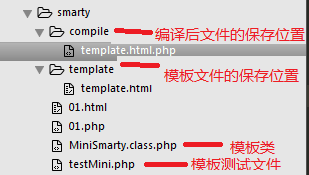本文实例讲述了Smarty模板类内部原理。分享给大家供大家参考,具体如下:
之前在学习ThinkPHP的时候,有接触到Smarty模板类,但是一直不知道其内部实现的原理,博主今天终于知道了其内部原理,其实也挺简单的,然后写了一个迷你版的Smarty模板类,对理解其内部原理有了很大的帮助。
1、迷你版Smarty类
首先上代码,最后再进行讲解。
项目结构图

MiniSmarty类代码(MiniSmarty.class.php)
|
1
2
3
4
5
6
7
8
9
10
11
12
13
14
15
16
17
18
19
20
21
22
23
24
25
26
27
28
29
30
31
32
33
34
35
36
37
38
39
40
41
42
43
44
45
46
47
48
49
50
51
|
<?php/** * 迷你模板类 */class MiniSmarty{ public $template_dir = '';//模板文件放置的目录 public $compile_dir = '';//编译后文件放置的目录 public $tpl_var = array();//模板赋值的变量 /** * 给模板进行赋值 * @param str $key 键 * @param mixed $value 值 * @return void */ public function assign($key,$value){ $this->tpl_var[$key] = $value; } /** * 编译模板,并引入编译后的文件 * @param str $template 模板文件 * @return void */ public function display($template){ $compile_file = $this->compile($template); include($compile_file); } /** * 将模板文件编译成php文件 * @param str $template 模板文件名 * @return str 编译文件名 */ private function compile($template){ $template_file = $this->template_dir.'/'.$template; //读取模板文件中的内容 $source = file_get_contents($template_file); //判断是否需要再次生产编译文件 $compile_file = $this->compile_dir.'/'.$template.'.php'; //如果存在编译文件且编译文件的修改时间比模板文件大,则不用再次编译,直接返回文件路径 if(file_exists($compile_file) && filemtime($compile_file) > filemtime($template_file)){ return $compile_file; } //解析{$}为<?php echo 等操作 $source = str_replace('{$', '<?php echo $this->tpl_var[\'', $source); $source = str_replace('}', '\'];?>', $source); //生成编译文件 file_put_contents($compile_file, $source); //返回编译后的文件路径 return $compile_file; }}?> |
测试模板类代码(testSmarty.php)
|
1
2
3
4
5
6
7
8
9
10
11
12
13
14
15
|
<?php//1、引入并创建模板实例include ('./MiniSmarty.class.php');$Smarty = new MiniSmarty();$Smarty->template_dir = './template';$Smarty->compile_dir = './compile';//2、给模板对象赋值$title = '两会召开';$content = '好奶粉,好会议,好新闻';$Smarty->assign('title',$title);$Smarty->assign('content',$content);//3、显示模板$template = 'template.html';$Smarty->display($template);?> |
模板文件(template.html)
|
1
2
3
4
5
6
7
8
9
10
11
12
|
<!DOCTYPE html><html><head> <meta charset="utf-8"> <meta http-equiv="X-UA-Compatible" content="IE=edge"> <title>{$title}</title> <link rel="stylesheet" href=""></head><body> <h3>{$content}</h3></body></html> |
编译后的文件(template.html.php)
|
1
2
3
4
5
6
7
8
9
10
11
12
|
<!DOCTYPE html><html><head> <meta charset="utf-8"> <meta http-equiv="X-UA-Compatible" content="IE=edge"> <title><?php echo $this->tpl_var['title'];?></title> <link rel="stylesheet" href=""></head><body> <h3><?php echo $this->tpl_var['content'];?></h3></body></html> |
代码都贴完了,最后解释一下。在测试模板类(testSmarty.php)文件中,首先是引入模板类文件,实例化模板对象,然后给模板对象赋值,最后显示模板。在模板类(MiniSmarty.class.php)文件中,有3个属性和3个方法,属性分别是template_dir 、compile_dir‘和tpl_var,含义分别是模板文件的路径、编译后文件的路径、模板对象的变量。3个方法分别是assign、display和compile,assign方法是给模板对象赋值,display方法是编译模板文件,并引入(显示)编译后的文件,compile方法是编译模板文件。编译模板文件的过程主要是将模板文件中的{$标签}解析成<?php echo $var?> 等php代码。
2、Smarty原理分析
工作流程
(1)把需要显示的全局变量,赋值,塞到对象的内部属性中的一个数组里
(2)然后编译模板,将{$标签}解析成相应的php echo 代码
(3)引入编译后的php文件
使用步骤
(1)Smarty是一个类,要使用的话,必须引入在进行实例化
(2)使用assign给模板赋值
(3)使用display方法【从编译到输出】
Smarty的缺点
(1)编译模板,浪费时间
(2)要把变量再重新赋值到对象的属性中,增大了开销
希望本文所述对大家基于smarty模板的PHP程序设计有所帮助。
原文链接:https://blog.csdn.net/baochao95/article/details/52248207











